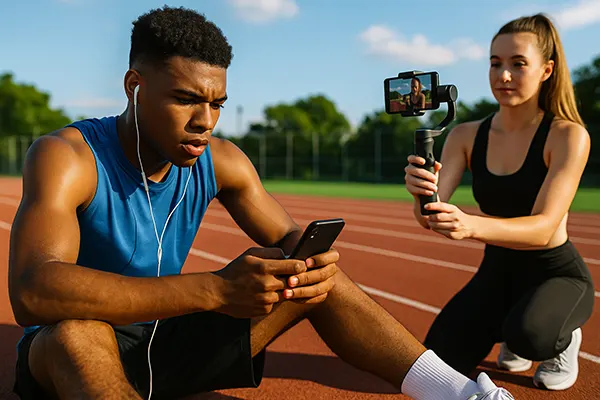In the modern sports landscape, social media plays a pivotal role in shaping the trajectory of young athletes’ careers. Beyond the traditional path of achievements on the field, digital presence has become an essential factor influencing recognition, marketability, and professional opportunities. This article delves into how online visibility affects athletes’ popularity, the sponsorship landscape, and personal branding, while also examining the risks and rewards associated with active digital engagement.
How Social Media Increases Visibility and Sponsorship Potential
For aspiring athletes, exposure is everything. Social media allows them to showcase their skills to a global audience without relying solely on traditional media or sporting events. Videos of training routines, match highlights, and behind-the-scenes content can rapidly attract followers and the attention of talent scouts.
This increased visibility often translates into tangible commercial benefits. Brands actively seek influencers with engaged audiences, and young athletes with strong online followings are considered valuable marketing assets. For example, a high school basketball player with half a million Instagram followers may be more appealing to sponsors than a lesser-known college athlete.
Furthermore, many professional teams and sports organisations assess a prospect’s digital reach when making recruitment decisions. A well-managed online presence can significantly elevate an athlete’s profile and serve as leverage during contract negotiations.
Real-World Cases of Online-Driven Career Growth
Several rising stars have successfully used social platforms to accelerate their careers. Take Emma Raducanu, for instance. Before winning the US Open, her Instagram feed already reflected a calculated blend of personality, training, and branding that captured sponsors’ interest. Following her victory, she became one of the most marketable athletes in the UK, signing deals with Dior, British Airways, and Evian.
Another example is Zion Williamson, who gained national fame through viral high school dunk videos on YouTube and Instagram. This digital exposure laid the groundwork for a highly anticipated college and NBA career, securing lucrative endorsement deals early on.
These examples demonstrate how social media can act as a springboard—not just a supplement—to traditional career paths in sports.
Risks and Ethical Challenges of Online Engagement
While the benefits of digital visibility are considerable, they come with significant risks. The pressure to remain constantly visible and engaging can affect mental health, especially in adolescence—a critical phase for emotional development. Young athletes often struggle with balancing online persona and private identity.
Moreover, a single misjudged post or controversial comment can have long-term consequences. Several athletes have lost scholarships or sponsorships due to resurfaced tweets or Instagram stories. The digital footprint is permanent, and what seems trivial at the moment might resurface years later with serious repercussions.
There is also a risk of manipulation by online agents or agencies promising fame in exchange for exploitative contracts. Without proper guidance, many young athletes become easy targets for misinformation or even fraud, especially in monetising their social media channels.
Guidelines for Responsible Social Media Use
Education is key. Schools, sports academies, and clubs must prioritise digital literacy. Teaching athletes how to navigate platforms responsibly—understanding privacy settings, content tone, and audience targeting—can prevent many issues.
It’s equally important to have a support system. Trusted family members, agents, or mentors should help review public posts and offer advice on brand partnerships. This ensures alignment with long-term career goals and personal values.
Finally, having a clear separation between personal and professional accounts can help reduce stress and control the narrative. Maintaining boundaries protects young athletes from overexposure and allows for more authentic interaction.

The Importance of Personal Branding for Career Longevity
In today’s highly competitive sports environment, talent alone is no longer enough. Personal branding has become an essential component of career management, even at the junior level. Athletes must think like entrepreneurs—crafting their image, values, and voice across multiple channels.
Branding isn’t about pretending to be something you’re not; it’s about emphasising strengths, communicating goals, and creating a relatable story. When done well, it humanises the athlete, builds trust, and fosters loyalty among fans and sponsors alike.
This long-term connection with an audience can be a safety net after an active sports career. Many athletes successfully transition into coaching, broadcasting, or entrepreneurship using their established digital identity as a base.
Strategic Tools for Building an Athlete’s Brand
Consistency is the cornerstone of effective branding. Athletes should maintain a steady tone, posting schedule, and visual style. Professional photos, quality video production, and curated captions all contribute to a recognisable digital persona.
Collaborations with brands, charities, or media personalities should reflect the athlete’s core values. For instance, supporting mental health initiatives can resonate powerfully with followers and sponsors alike, reinforcing the athlete’s integrity and purpose.
Analytics tools available on Instagram, TikTok, and X (formerly Twitter) provide invaluable insight into audience preferences. Understanding what content performs best allows athletes to refine their strategy, ensuring they grow their community with intention and impact.
